The 2024 general election in numbers: From historic results to huge vote swings
The Independent’s data correspondent looks at last night’s shock figures, from the closest seats to the biggest swings
Your support helps us to tell the story
From reproductive rights to climate change to Big Tech, The Independent is on the ground when the story is developing. Whether it's investigating the financials of Elon Musk's pro-Trump PAC or producing our latest documentary, 'The A Word', which shines a light on the American women fighting for reproductive rights, we know how important it is to parse out the facts from the messaging.
At such a critical moment in US history, we need reporters on the ground. Your donation allows us to keep sending journalists to speak to both sides of the story.
The Independent is trusted by Americans across the entire political spectrum. And unlike many other quality news outlets, we choose not to lock Americans out of our reporting and analysis with paywalls. We believe quality journalism should be available to everyone, paid for by those who can afford it.
Your support makes all the difference.The dust has mostly settled on this year’s UK general election, with the polls closing at 10pm on Thursday and virtually all votes counted overnight*.
Labour has secured a historic win with a significant majority – though less than some polls predicted – while the Conservatives have suffered their lowest-ever number of seats since 1832.
See the latest seat count and constituencies declared live here
But with some surprising twists and dramatic seats on knife-edge losses, let’s dive into the election by numbers.
1. Labour gained 211 seats – but just 1.6 per cent increase in share of the vote
Though pollsters were predicting a large Labour majority in both seats and vote share, Sir Keir Starmer’s party has not managed to move the needle far when it comes to its proportion of national votes overall.
Due to lower turnout, Labour won fewer votes than at the last election, at 9.7 million compared to 10.3 million in 2019.
Labour’s total vote share sits at 33.8 per cent, a minute increase from 32.2 per cent in 2019, and well below the Tories’ 43.6 per cent in the last election. Nonetheless, Labour has won 412 seats, an increase of 211 from 2019.
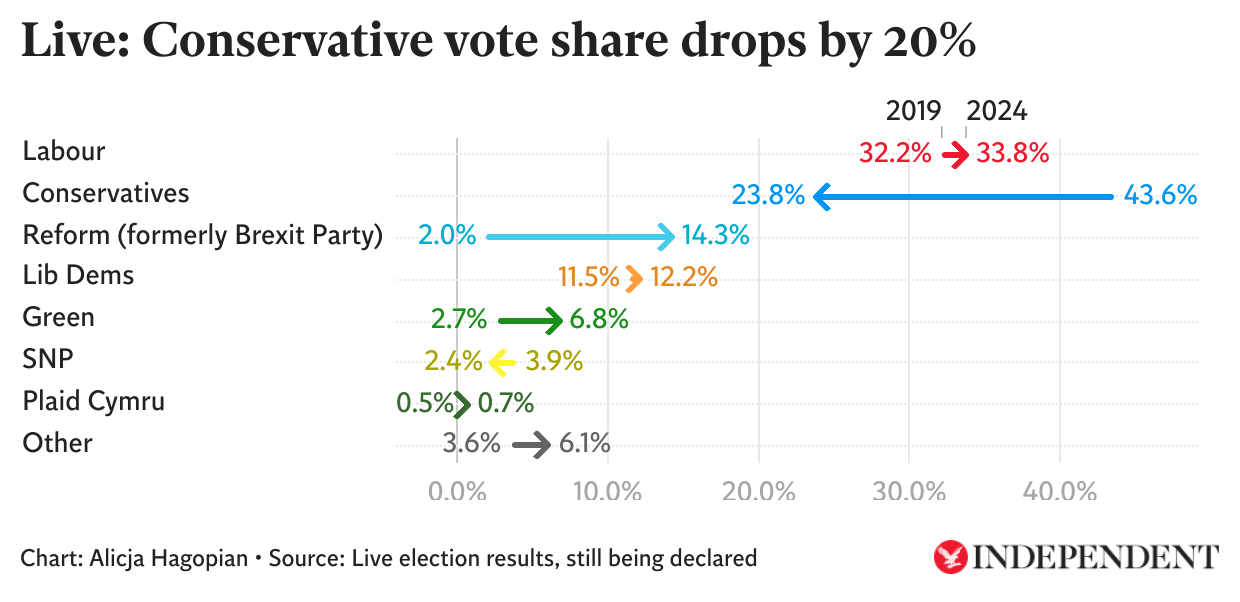
It is possible that, with all polls predicting widespread Labour wins, left-wing voters were more emboldened to vote for smaller parties; a theory supported by the fact that Lib Dems, the Green Party, and even Reform all saw record numbers.
On the other hand, the Conservative Party has seen crippling losses by both metrics. It has lost 251 seats, and nearly half of its supporters nationwide, with national vote share at just 23.7 per cent (6.8 million votes).
2. Lowest turnout in 20 years
With the last seat still being calculated, turnout has been estimated at 59.8 per cent, the lowest since 2001 (59.4 per cent), and final figures could be lower.
This is down by around 7.5 per cent from 2019, when 67.3 per cent of eligible voters showed up at the ballots.
While it is too soon to see a demographic breakdown of voter turnout, opinion polls right before the election (2 July) suggested that high levels of young people (44 per cent) would not be voting.
3. A right-wing alliance?
Though often considered two sides of the same coin, this election showed Tory voters and Reform voters are not entirely interchangeable.
While we lack the deeper voting demographics until a later stage, it’s safe to say that not all votes lost by the Conservatives went to Reform. The Tories have lost around 19.8 per cent of national votes but Reform has 14.3 per cent, and opinion polls showed that Nigel Farage’s party gained votes from different ends of the political spectrum.
There has been much talk of a right-wing alliance; while the two parties combined still won only 126 seats, Reform crippled the right-wing vote in dozens more seats.
Combined, the parties would have over 38 per cent of the national vote share, beating Labour (but not the slew of left-wing parties).
However, both parties have denied allegations that they would strike a deal, with Mr Farage saying he wants “nothing to do with” the Tories.
4. The closest seats won by a hair
No fewer than 113 seats (17.4 per cent) were won with very tight majorities of under 5 per cent ahead of the next party.
This is the case for three out of five Reform seats, including Basildon and Thurrock, where a recount was called to determine a Reform win (by just 98 votes).
Tory chairman Richard Holden scraped a win by the skin of his teeth in Basildon and Billericay, with just 20 votes over Labour’s candidate.
Link to interactive map with closest seat margins here
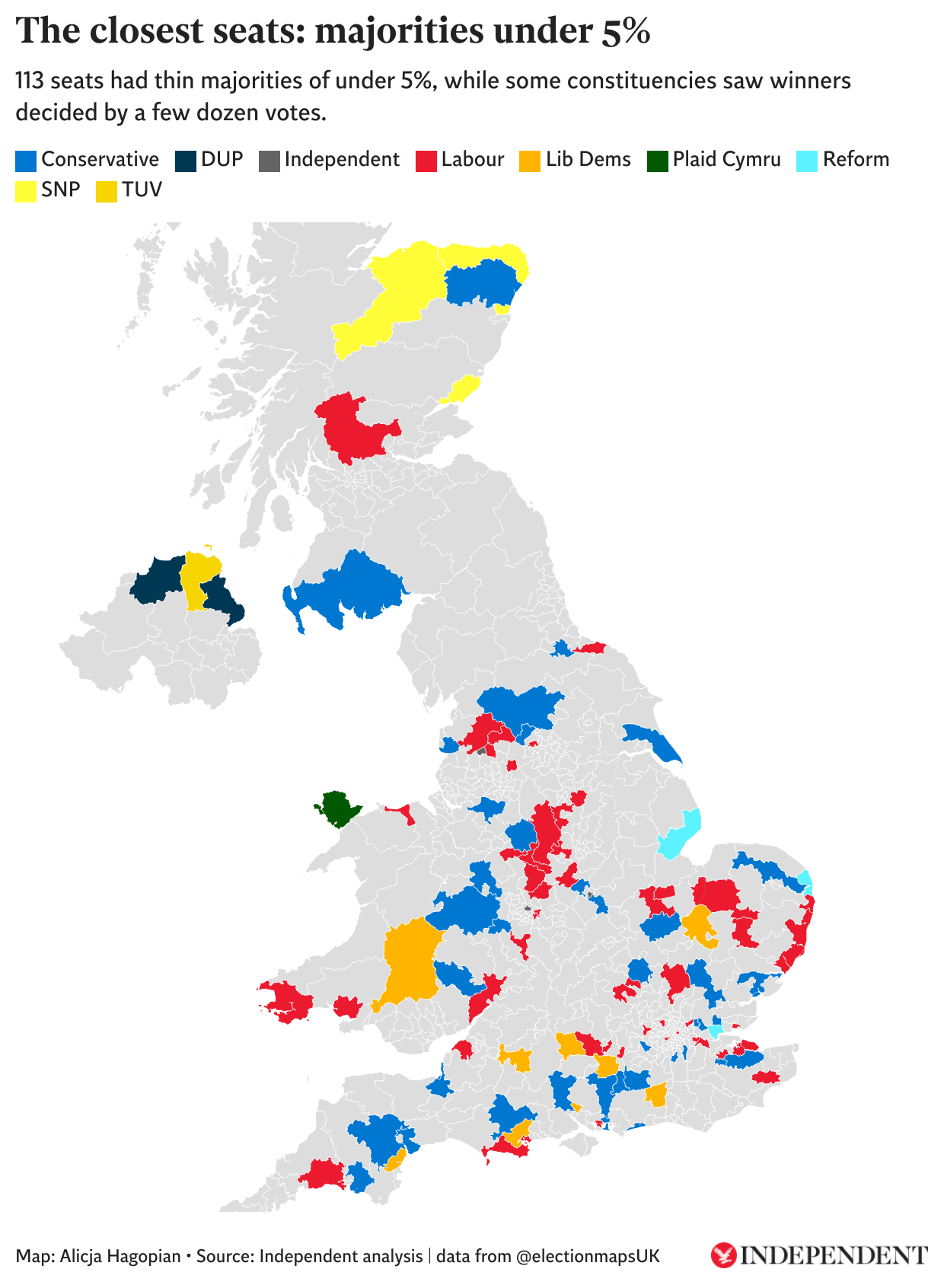
In fact, 19 seats had scarce majorities of under 500 votes; with the two tightest seats won by the equivalent of a football squad.
Labour took seats from the Tories by just 15 votes (Hendon) and 18 votes (Poole). Labour MPs also won by a handful of votes in North West Cambridgeshire and Havant.
5. Labour won Scotland
Several of the biggest swings this election came in Scotland, where Labour made significant headway in some constituencies for the first time.
Labour won 37 seats in Scotland, up from just 1 in 2019, with vote swings of up to 31.3 per cent. Most of these seats were from the SNP, who have ended with just nine seats*.
6. The biggest swings
The greatest Labour vote swings in historically Tory constituencies came in Tamworth (up 22 per cent to 45.3 per cent), and Finchley and Golders Green (up 19.9 points to 44.3 per cent).
Meanwhile, the Conservatives only saw an increase in vote share in one constituency, Liverpool Riverside, but the 2.3 per cent increase still left them 50 points behind Labour (61.9 per cent).
Link to interactive map with vote swings here
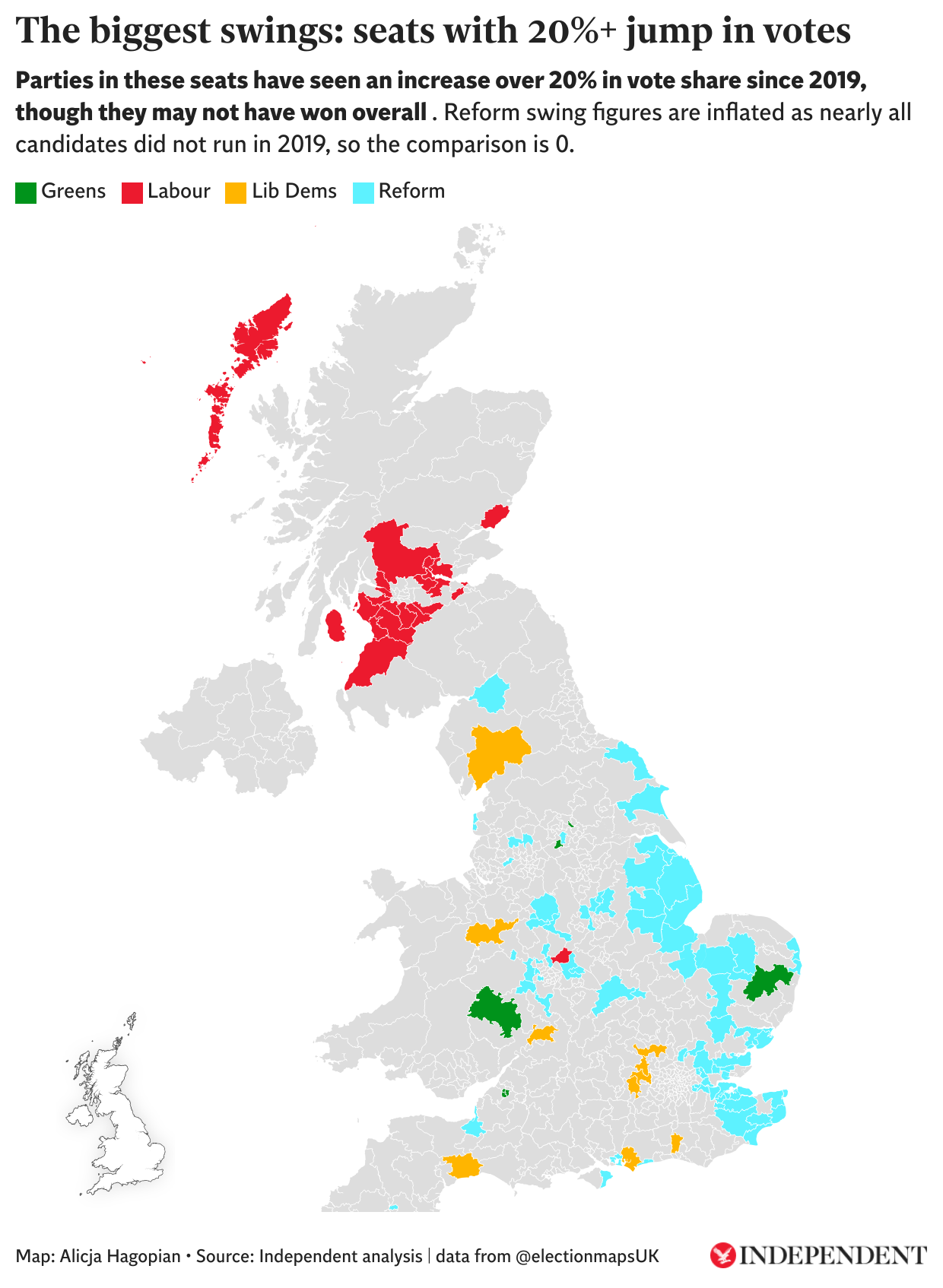
The Lib Dems had the greatest swings in former Tory seats, largely in the South East and West. In fact, the Lib Dems had one of the highest swings of this election in North Shropshire, finishing with 52.9 per cent, five times higher than the 2019 result of 10.4 per cent.
The Greens made significant gains in dozens of constituencies, with a swing of 34.4 per cent in North Herefordshire, which marked a historic win for candidate Ellie Chowns.
As a largely newly formed party, almost all Reform votes look like gains in vote share, as there is no comparison to 2019.
Nonetheless, the party made huge strides even in constituencies where it did not win seats: notably 30.8 per cent in Stratford-on-Avon, and 30.1 per cent in Castle Point.
7. War in Gaza cost Labour seats and votes
The major parties’ stance on Gaza was a divisive topic during this election, with one in five Asian voters saying it would affect how they voted.
In several Labour constituencies, particularly those with a higher Muslim population, independent candidates were running on the promise that they would have a clearer pro-Palestine and ceasefire stance.
In some seats, the independent candidate has ousted a Labour stronghold. In Islington North, Jeremy Corbyn retook his seat, beating Labour by 7,247 votes. Mr Corbyn has been public about his support for Palestine.
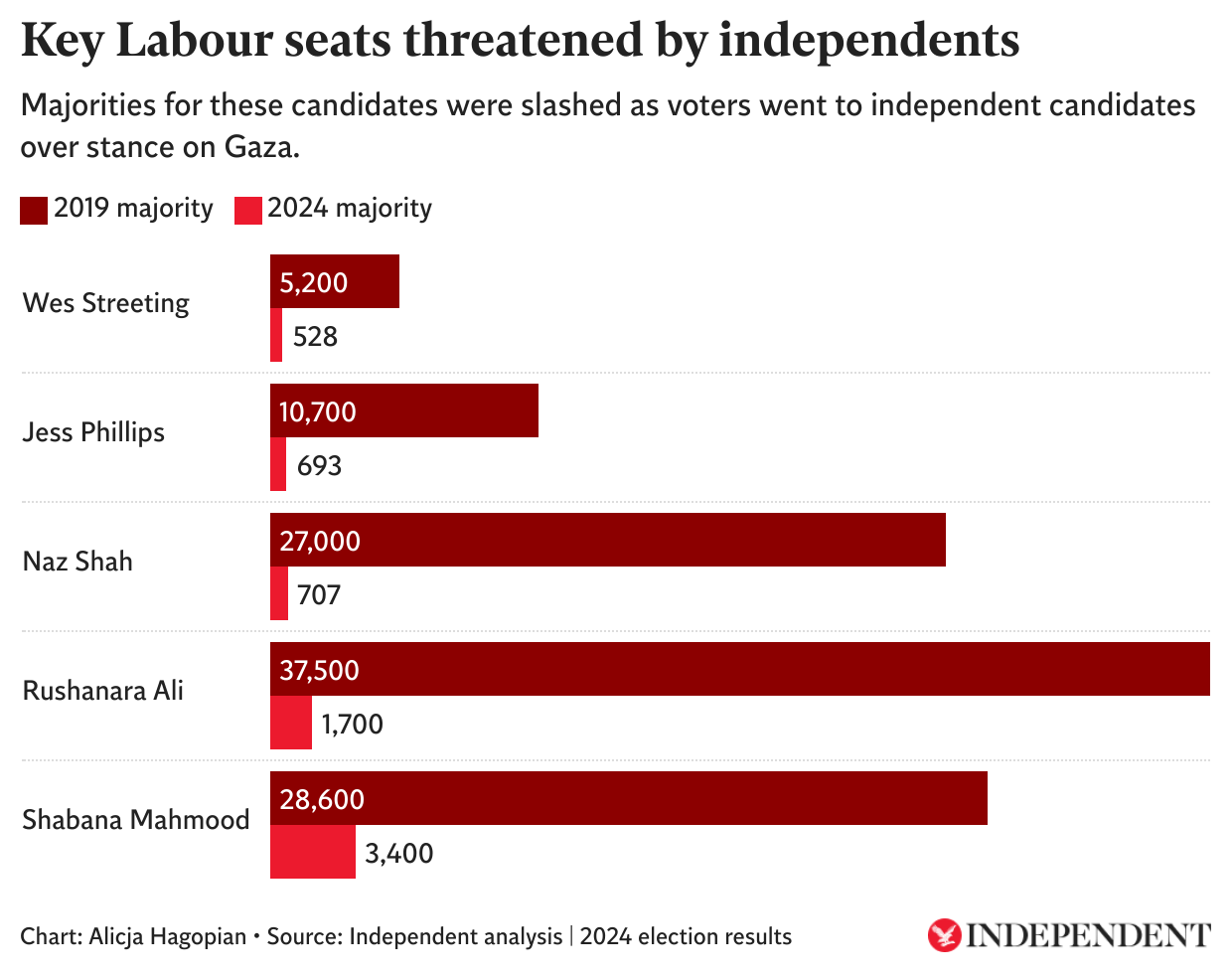
Meanwhile, independent candidates have booted Labour out in four seats, while Adnan Hussain took Labour’s seat in Blackburn by just 132 votes, saying: “This is for Gaza.”
In others, strong Labour majorities have been significantly diminished by voters turning to independents.
Key Labour figures have been hit by shrinking majorities, including British Asian MP Naz Shah who won her seat by just 707 seats, and shadow cabinet ministers Wes Streeting and Shabana Mahmood.
8. Making history
Today’s results have made British history, but not quite how opinion polls expected.
Labour has won an enormous 412 seats and a 170-seat majority. This is in line with Labour’s 1997 victory but did not quite break its record, when 418 seats were won with a 179 majority.
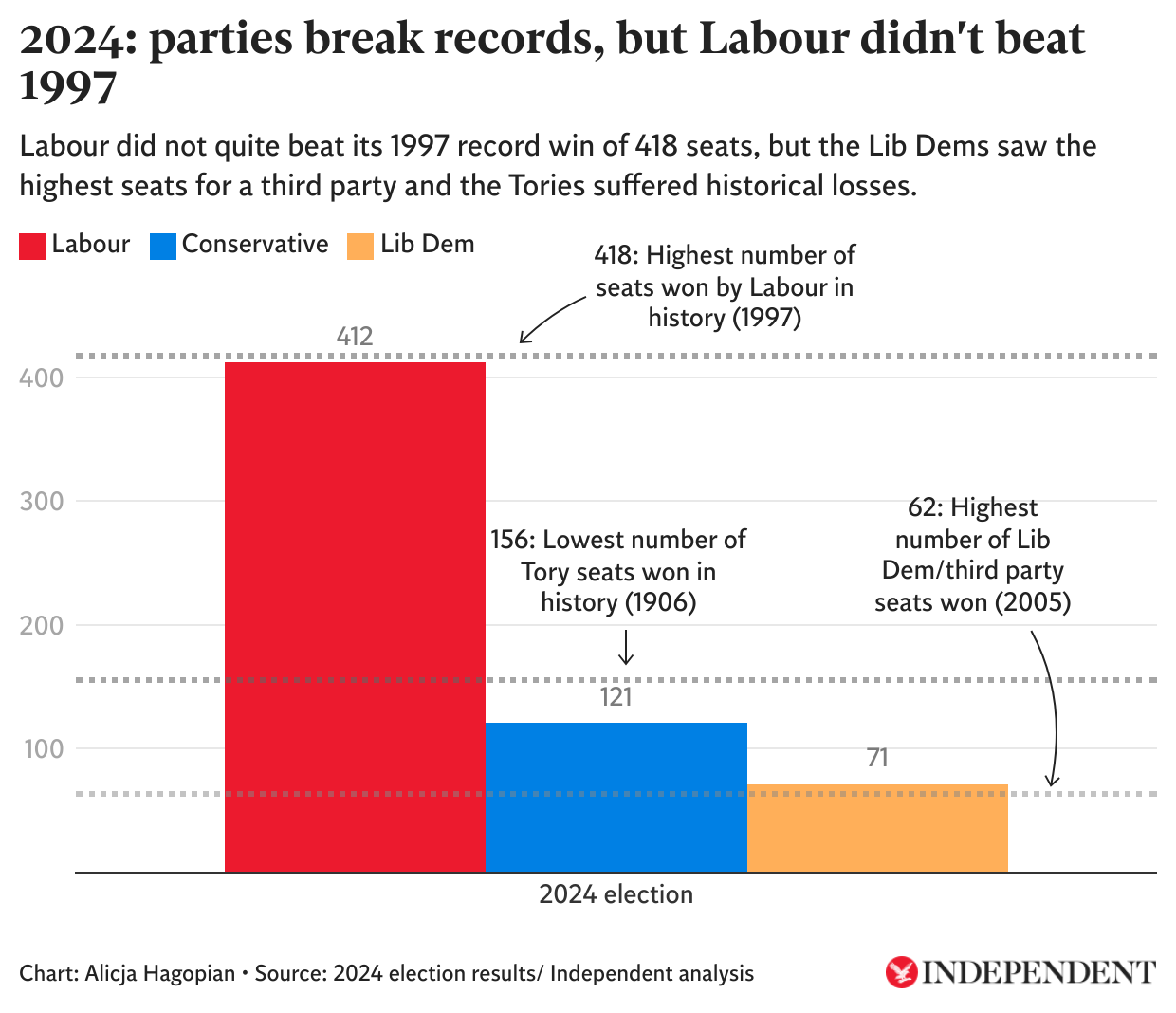
The Tories have broken some less positive records today, tanking below their lowest number of seats in history. The Conservatives are set to win just 121 seats in this election, lower even than their 1906 number of 156.
Meanwhile, the Lib Dems have also exceeded expectations and their own records, winning 71 seats*. The Lib Dems previously won 62 seats in 2005, led by Charles Kennedy. This is also the highest number of seats for a third party in modern history.
9. Women now make up four in 10 MPs
This parliament will now be the most diverse in British history, in terms of gender, ethnicity, and likely sexuality.
As the final results roll in, the public has voted in some 263 female MPs spanning most parties.
Labour representatives make up the majority of this group (72 per cent), with 190 female MPs, while 29 women make up a quarter of the Tories’ total MPs.
More than four in 10 elected Liberal Democrats are women (32 out of 71), while three of four Green wins are women. While 16 per cent of Reform’s candidates were women, none of them won seats.
A record number of 87 ethnic minority MPs have been elected today, making the UK’s most diverse parliament ever up from 66 in 2019, according to analysis by think tank British Future.
This means that 13 per cent of MPs are now from an ethnic minority background, compared to around 14 per cent of the UK electorate.
*One outstanding seat, Inverness, Skye & West Ross, is due to be declared on Saturday morning

Join our commenting forum
Join thought-provoking conversations, follow other Independent readers and see their replies
Comments